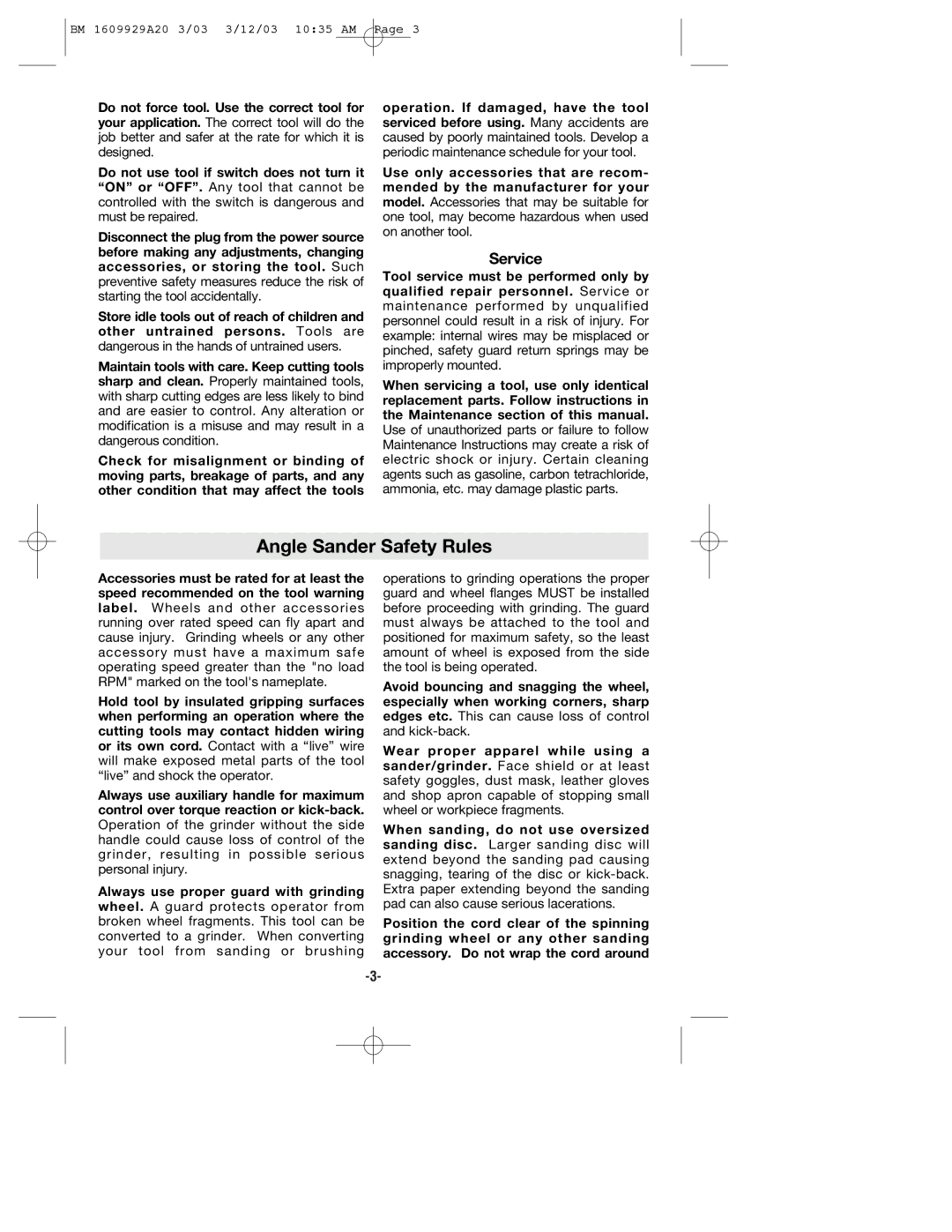
BM 1609929A20 3/03 3/12/03 10:35 AM Page 3
Do not force tool. Use the correct tool for your application. The correct tool will do the job better and safer at the rate for which it is designed.
Do not use tool if switch does not turn it “ON” or “OFF”. Any tool that cannot be controlled with the switch is dangerous and must be repaired.
Disconnect the plug from the power source before making any adjustments, changing accessories, or storing the tool. Such preventive safety measures reduce the risk of starting the tool accidentally.
Store idle tools out of reach of children and other untrained persons. Tools are dangerous in the hands of untrained users.
Maintain tools with care. Keep cutting tools sharp and clean. Properly maintained tools, with sharp cutting edges are less likely to bind and are easier to control. Any alteration or modification is a misuse and may result in a dangerous condition.
Check for misalignment or binding of moving parts, breakage of parts, and any other condition that may affect the tools
operation. If damaged, have the tool serviced before using. Many accidents are caused by poorly maintained tools. Develop a periodic maintenance schedule for your tool.
Use only accessories that are recom- mended by the manufacturer for your model. Accessories that may be suitable for one tool, may become hazardous when used on another tool.
Service
Tool service must be performed only by qualified repair personnel. Service or maintenance performed by unqualified personnel could result in a risk of injury. For example: internal wires may be misplaced or pinched, safety guard return springs may be improperly mounted.
When servicing a tool, use only identical replacement parts. Follow instructions in the Maintenance section of this manual. Use of unauthorized parts or failure to follow Maintenance Instructions may create a risk of electric shock or injury. Certain cleaning agents such as gasoline, carbon tetrachloride, ammonia, etc. may damage plastic parts.
Angle Sander Safety Rules
Accessories must be rated for at least the speed recommended on the tool warning label. Wheels and other accessories running over rated speed can fly apart and cause injury. Grinding wheels or any other accessory must have a maximum safe operating speed greater than the "no load RPM" marked on the tool's nameplate.
Hold tool by insulated gripping surfaces when performing an operation where the cutting tools may contact hidden wiring or its own cord. Contact with a “live” wire will make exposed metal parts of the tool “live” and shock the operator.
Always use auxiliary handle for maximum control over torque reaction or
Always use proper guard with grinding wheel. A guard protects operator from broken wheel fragments. This tool can be converted to a grinder. When converting your tool from sanding or brushing
operations to grinding operations the proper guard and wheel flanges MUST be installed before proceeding with grinding. The guard must always be attached to the tool and positioned for maximum safety, so the least amount of wheel is exposed from the side the tool is being operated.
Avoid bouncing and snagging the wheel, especially when working corners, sharp edges etc. This can cause loss of control and
Wear proper apparel while using a sander/grinder. Face shield or at least safety goggles, dust mask, leather gloves and shop apron capable of stopping small wheel or workpiece fragments.
When sanding, do not use oversized sanding disc. Larger sanding disc will extend beyond the sanding pad causing snagging, tearing of the disc or
Position the cord clear of the spinning grinding wheel or any other sanding accessory. Do not wrap the cord around
